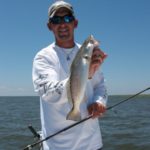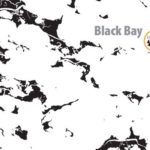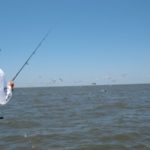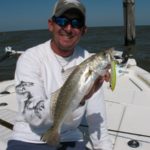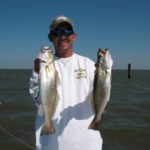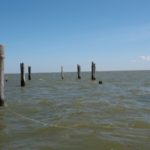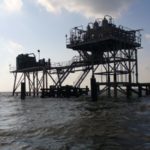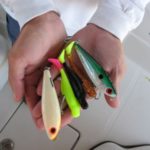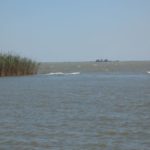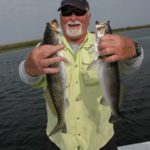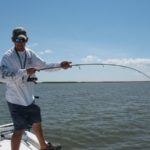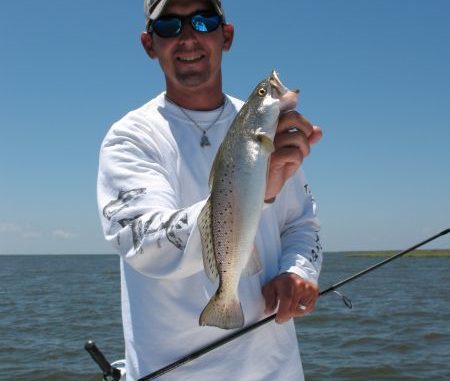
Fish these four Black Bay hotspot to catch all the trout you can handle this month.
July anglers can sometimes let a little heat and humidity intimidate them.
“I’ll fish until summer sets in; then I’ll wait till fall to go back on the water, when it’s cooler,” they say.
Wimps.
Wise up! This is Southeast Louisiana, where it won’t cool down until at least October. Actually, we often find ourselves still running the A/C in December.
You’re gonna be off the water a loooong time waiting for it to cool down. So get some resolve, slather on the sunscreen, find a way to produce some shade (i.e., Bimini top, T-top, beach umbrella, sombrero, etc.) and get out there for the Black Bay burn — where the fishing is on fire, not you!
I’m amazed by the incredible numbers of speckled trout Black Bay hotspots produce year after year. You’d think with so many anglers plying the same waters and the same basic spots day after day and year after year they’d just run out of fish.
But Louisiana has an incredible fishery that renews itself continually, so no matter how many fish the weekenders catch on Saturday and Sunday, you can go back on Monday and do it again.
I was feeling overdue for a Black Bay trip when Capt. Chris Pike (504-427-4973) offered to take me. We saddled up his 24-foot Skeeter Bay bronco at his dock in Delacroix Island and his 300-horsepower Mercury Verado got us underway.
Pike ran a route through Four Horse Lake, Pato Cabello and Lake Campo, and then kept heading out toward our goal — Iron Banks.
I was eager to see what remained of the perennial hotspot that I fished decades ago when there was a shell bank island, barges and some sort of harbor. I remember barges loaded with rocks squatting on the bottom and rusting away, along with hazardous reef of huge underwater rocks that spilled out of the barges and lurked just below the surface to ambush any unwary boater who wandered too close.
Many a prop and lower unit died there.
I also remember a lot of scrap metal, cables and shards of rusted metal — all good places to lose your tackle — but lots of big trout lurked there, too, and that’s what kept drawing us back summer after summer.
Ain’t dare no more
Like so much of our coastline, Iron Banks has vanished beneath the seas. A handful of lonely pilings, like silent sentinels, are all that mark the spot of an island that once was.
But don’t let appearances fool you. The iron-like stone that gave Iron Banks its name is still there, and it still draws fish like road-kill attracts buzzards.
The morning was windy and blowing much harder than forecast, so Pike opted to make a brief stop to drift and troll near the remnants of the old Conservation Camp before we ran out into open water for the jarring ride to Iron Banks.
“Any wind over 10 mph makes it very rough at Iron Banks because it’s all open, unprotected water,” he said. “A stiff southeast wind makes it the roughest, but a light wind from any direction is OK. A strong west or southwest wind makes it unfishable.”
We pecked away at a few trout, and then buttoned down for the ride to the Iron Banks. Once there, Pike motored slowly to the set of tall pilings and tied us off on the far end.
“It’s best to approach from the north side — the Bayou Terre aux Boeufs side — but motor or troll in slowly, from about a ¼ mile out,” he said. “There is so much debris in the water you can get in trouble quick.”
Pike said you can catch fish anywhere around Iron Banks, and the biggest mistake boaters make is trying to get right on top it.
“The fish are usually holding 20 to 30 yards off the structure, especially on a strong tide,” he said. “The only time I try to fish closer is on slow tide days. I prefer to anchor off and cast with the wind at my back into or alongside any current lines, especially if you see any sign of bait in the area.
“Get that live shrimp in the water and let the fish come to you.”
But Pike said don’t even think about fishing the bottom out here.
“This is topwater or cork fishing only,” he said. “Put anything on the bottom anywhere out here and you’ll lose it. When the conditions are right you can get some great blow-ups on the Badonk-a-donk topwaters and on shallow subsurface baits. But generally you’ll want to use live shrimp (or live croakers later in the summer) on a snap-on cork or a tie-on cork or even a sliding cork set to 3 feet, but never on the bottom at Iron Banks.
“On the river side of Iron Banks from the two pilings protruding slightly above the surface east to that single piling with the pipe there is a solid wall of debris just 2 feet below the surface. The whole area is just littered with huge rocks and rebar and all kinds of metal debris, but that’s what keeps drawing the fish here.
“There is a deeper channel about 20 to 30 yards out on the river side of those almost-submerged pilings, where the water is 7 or 8 feet deep. The trout like to get along the edges of that channel — but again, fish it under a cork or lose your line. And while anywhere out here is fishable, I do like the northwest corner, the corner facing Belle Island, best.”
The Wreck
“The area we call the Wreck is not a single structure but a big area that encompasses the big production platform, numerous nearby satellite wells that feed it and some nearly submerged structure of a former platform,” Pike said. “It’s a wide area, and all of it holds fish.”
He said to anchor upcurrent and cast toward the structure, but don’t try to get in too close.
“The stronger the tide the farther off the structure the fish will hold,” he said. “Always approach the structure slowly, whether you are fishing the main rig, the small platforms or the wreckage, and look for current lines and signs of bait. If you see that, start there.
“Give the area 15 minutes to settle down and produce, and if it doesn’t, move and try again until you find them.”
Pike said you can fish the Wreck area two ways.
“Live shrimp under a cork or on bottom at the main platform and along the nearby satellite wellheads,” he said. “But if you fish around the wreckage, do that under a cork. Anytime you come out here to fish Iron Banks or the Wreck, come prepared to lose tackle. It’s going to happen. Look at it as part of the price you pay to fish here, like a business owner would say, ‘It’s the cost of doing business.’
“And you should bring a spare anchor, because the Wreck area eats anchors. I’ve lost several out there.”
Pike said live shrimp are definitely the menu trout prefer this month, but you should add live croakers to their diet next month.
If you like to toss plastics, his favorites is the Bomber Mud Minnow.
Stone Island
About three miles due north of Iron Banks is Stone Island, another Black Bay hotspot that produces fish year after year. And it’s a favorite summer-time target of Capt. Ron “Ahab” Broadus (504-914-6063), who also docks his ride in Delacroix Island.
Broadus said his routine is to pick days with a decent tide range and light winds in any direction except from the west.
“I do not even go out there on days with a west wind,” he said. “The water gets too muddy.”
But when the winds are right, he heads out with a plan in mind.
“Once there, I head directly to the east side of the island, and I look for any sign of bait on the corners,” Broadus said. “The Wreck side of Stone Island has good rock corners that hold trout, flounder, reds and drum, and many of the specks we pull out of there are very nice-sized.”
Broadus said there is some submerged structure in there, so ease in slowly with your trolling motor.
“I’ll troll and fish along that whole rock shoreline if there aren’t any other boats there,” he said. “Live shrimp under a cork is the best bait, but topwater or subsurface baits and soft plastics tight-lined or under a cork should produce, also.”
While the island has fallen prey to erosion, fish-holding structure remains.
“My other tactic is to troll into the cove and work my way to the south point on the Iron Banks side of the island,” Broadus said. “That land was once at least 50 feet farther out than it is now, but that underwater reef is still a hotspot for trout, reds and drum.
“I do see boats fishing on every side of Stone Island and they might be catching fish, but I only fish the east or south sides of the island itself. However, I love to fish the small chair-wells and satellite structures on the north side of the island. I like to fish either live shrimp on a Carolina rig or a sliding cork rig set to fish about 4 feet deep.
“And I also do very well at those structures tight-lining soft plastics. The Deadly Dudley slammin Sammy color and the Matrix Lemonhead color have been very effective for me out there.”
Lonesome Island
Broadus has another ace up his sleeve: Lonesome Island.
“You’ll have to add Lonesome to your list of stuff that ain’t there no more, but you can still catch fish at the underwater reef that once was the island,” Broadus said.
He said the “island” is about three miles to the northwest from Stone Island, or if you’re coming out of the mouth of Bayou Terre aux Boeufs you just head due south for about 3 ½ miles.
“Approach slowly because not much of anything protruding above the surface, but you’ll know where it is because you can bet some boat or boats will be on it,” Broadus said. “My rule of thumb for Lonesome Island is this: First, I never go if the tide is less than .7. You need good moving water out there for that spot to be productive.
“Second, I move around it very slowly because the reef is very shallow. Shallow water also conducts noise very easily, so try to move around as quietly as possible if you hope to catch those ultra-wary big trout.
“Third, keep in mind that the prime spot where the fish tend to hold can only accommodate three boats, four max. And you have to fish very courteously out there. You can also fish over the section of the island that is in about 4 foot of water, and on the south side in about 6 foot of water is a good place to fish live shrimp on a Carolina rig. I like it best when nobody is out there so I can troll around until I find the fish.”
And there is no better time to be at the reef than now.
“If you want to fish Lonesome, this is the month to do it because usually by August the action there slows down significantly,” he said.
“Cast and Blast” Charters Capt. Chris Pike can be reached at 504-427-4973. Capt. Ron “Ahab” Broadus can be reached at 504-914-6063.
